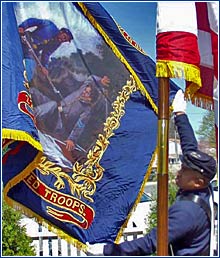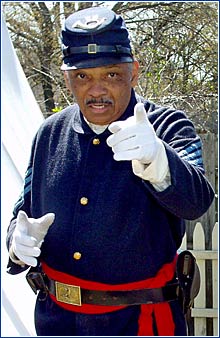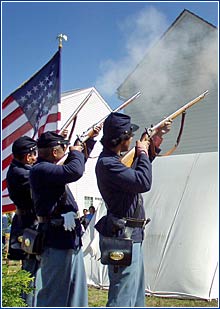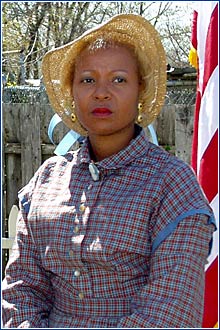BLACK CIVIL WAR REENACTORS UNVEIL NEW FLAG
U.S. Colored Troops Ceremony Marks Anniversary of Conflict's Start
By Hoag Levins
 | |
 April 20, 2003
April 20, 2003
LAWNSIDE, N.J. -- Much like the battles over which it once waved, this was a flag both grim and glorious, admitted Rashid Khan as he unfurled it on

Photo: Hoag Levins
|
| Charles Harris, a Civil War reenactor from Neptune, N.J., displays the newly-reconstituted flag of the 22nd US Colored Troops Infantry Regiment at a ceremony at the Peter Mott House. Larger photo. | the front lawn of the Peter Mott House last Sunday.
The brilliant blue banner, the official ensign of the 22nd US Colored Troops Infantry Regiment, depicts a black Union soldier pressing a bayonet to the chest of a defeated Confederate corporal.
'Hated this flag'
"The Confederates really hated this flag," said Charles Harris with a broad smile. Like Khan, he was dressed in the heavy blue wool of a Union Army soldier.
Harris, a 52-year-old union electrician from Neptune, and Khan, a 65-year-old retired police captain from Asbury Park, are both members of an Asbury Park Civil War reenactor group created in 1999 to portray the regiment of black army volunteers organized in in 1864.
The original 22nd was comprised of New Jersey recruits who went through initial training at Camp William Penn near Philadelphia before being sent south for action in a number of campaigns.
'Siege of Richmond
The 22nd was one of the black regiments that took part in the siege that destroyed Richmond, Va., and ultimately ended the war. On April 2, 1865, led by regiments of African-American soldiers, Abraham Lincoln's victorious army finally marched into the center of what had been the capital of the slavery republic of southern states. On April 5, the same Union troops gathered to salute the President himself, who arrived to tour the ruins of the city. Four days later, at nearby Appomattox, the remnants of the Confederate army surrendered. Six days after that, Lincoln was assassinated in a Washington theater and the 22nd was one of the army units dispatched

Photo: Hoag Levins
|
| Rashid Khan, a retired Asbury Park police captain, heads the 22nd reenactors. 'We want to be authentic,' he said. | across the Maryland countryside in pursuit of his assailants.
Sunday's event at the Mott House was part of a larger regional living history commemoration of the 142nd anniversary of the start of the Civil War that freed America's slaves.
Authentic Encampment
Jointly conducted by the Camden County and Lawnside Historical Societies, the activities featured a five-man detachment of reenactors from the 22nd. The encampment was complete with 1860's tent, sleeping cot, cooking gear and black powder weapons that would, later in the afternoon, blast a salute over the Mott House, believed to have once been a station on the Underground Railroad.
"This is a really good fit for us," said Lawnside Historical Society president Linda Waller. "Peter Mott's mission was to help people become free and members of the 22nd US Colored Troops took gun in hand and fought for the same thing. Plus, the experience of seeing Civil War soldiers and their gear is a great way to gets kids interested and involved here."
The day also marked the debut of the 22nd's just-completed flag. Although two originals of the flag are still known to exist, this was the first time the banner flew above uniformed troops since the Army unit was disbanded in the late 1860s.
Ongoing research
Kahn explained that the flag project was the latest result of the group's ongoing research into every aspect of the 22nd's daily life and operations. The group, with about 25 members from the Monmouth County area in northern New Jersey, has participated in Civil War reenactments from New England to Virginia.
"We are not just a bunch of guys who get together in hot wool

Photo: Hoag Levins
|
| Three members of the 22nd fire a black powder salute over the Peter Mott House in a ceremony jointly sponsored by the Lawnside and Camden County Historical Societies. Larger photo. | suits and randomly run around a field carrying nine-pound guns," said Khan, who is the administrator of the unit. "We actually train just like Civil War soldiers. We march the same way. We drill the same way. We fire our weapons the same way. We want to be authentic."
Khan and several other members of the troop explained they had initially been inspired to become Civil War reenactors by the movie "Glory." Khan said he had seen the movie more than ten times. "Every time you watch it, you see some detail or meaning you missed before," he explained. "That movie really helped make us all more aware of the role of black soldiers in the war."
Denzel Washington
Released in 1989, "Glory," starring Denzel Washington, is the story of the 54th Regiment of Massachusetts Volunteer Infantry, the first black unit of the Union Army to see action in the Civil War. That July, 1863, beach-front battle was for Fort Wagner which guarding the approaches to the harbor at Charleston, South Carolina. It was a suicide mission. But it also became a widely celebrated symbol of the bravery and determination of the hundreds of thousands of African Americans who ultimately fought for the Union in the U.S. Colored Troops and other units.
Khan and Harris both noted that the perspective of blacks was different from that of whites in the Union Army. Most who joined up were former slaves or sons of slaves who had relatives still entangled in the system of bondage and forced labor the Confederacy fought to maintain.
"It's important to know that those black men didn't fight for medals," said Kahn. "They didn't fight for money and they didn't fight for honor. They fought for freedom of the most basic

Photo: Hoag Levins
|
| Women traveling with black Civil War units often served as spies and assassins. Teresa Jones from Neptune portrayed the role in period dress. | kind -- it was the only thing that meant anything to them."
'Very emotional'
"That's why," he said, "a lot of us are really trying to get a sense of what they might have felt as they walked and ran and shot their way across those battlefields. And that's also why this hobby can sometimes get very emotional on a personal level."
Because of the cumbersome nature of the process, black powder muskets could only be reloaded and fired two or three times before masses of the rival armies smashed into each other, explained Harris. "Then, soldiers were so close, it was bayonets and bare hands," he said. "Black soldiers were known for their hand-to-hand combat skills and that's the spirit captured in the image the 22nd selected for its flag."
In most of its modern-day appearances, the 22nd is accompanied by an official "camp lady," also dressed in period costume. Sunday's female reenactor was Teresa Jones, from Neptune, who has been appearing with the group for the last three years.
Female assassins
"However, 'camp lady' does not mean what many think it means," Kahn explained to the audience on the Mott House's side lawn. "Many of the black women who moved with the Union troops actually served as spies and assassins. In fact, they were the only people who could walk into a Confederate camp unchallenged. Why? Because black women were expected to be there and no one questioned their coming and going.
"But many a Confederate camp woke up the next morning to find a colonel or a major mysteriously dead with a small bullet in their heads," said Kahn. "Even then, they never really thought about that black woman who was back in camp the next day -- with a reloaded derringer again strapped on her thigh."
All Rights Reserved © 2003, Hoag Levins
HoagL@earthlink.net
About this Web site
| 








